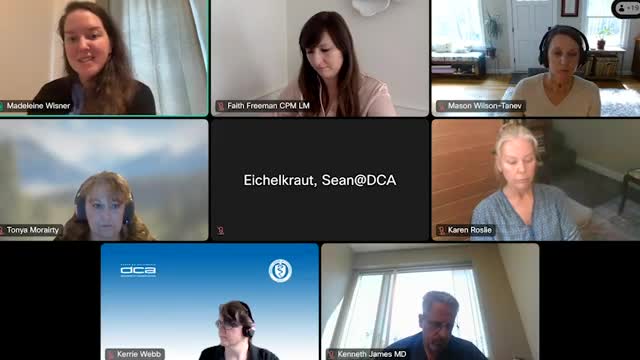Midwife‑researcher presents interviews identifying fear of abandonment and distrust as drivers of 'free birth'
November 05, 2025 | Medical Board of California, Other State Agencies, Executive, California
This article was created by AI summarizing key points discussed. AI makes mistakes, so for full details and context, please refer to the video of the full meeting. Please report any errors so we can fix them. Report an error »

Mason Wilson Tanev, a licensed midwife and doctoral candidate, presented qualitative research from 24 interviews (families who free‑birthed, licensed and non‑licensed midwives, and adults born via free birth) about why people plan births without a credentialed attendant.
Tanev said five themes accounted for most decisions to free birth: (1) desire for autonomy and control over interventions, including the ability to decline procedures; (2) distrust of both hospital systems and licensed midwifery when families perceive midwives will prioritize license protection; (3) fear of abandonment tied to regulatory limits (notably the 42‑week cutoff that can trigger transfer or discontinuation of care); (4) heightened concern during COVID‑19 (visitor limits, masking); and (5) a smaller group who made a positive, philosophical choice for unassisted birth as an affirmation of bodily sovereignty.
Tanev emphasized the regulatory dynamic she said drives the fear of abandonment: current practice law limits how long a licensed midwife can continue care in some circumstances, and families told interviewers they left care or chose free birth rather than transfer at 42 weeks. "Licensed midwives are beholden to the state, not to me," one interviewee said; another told Tanev, "I would have loved a midwife, but only if I knew I could say no to something without being dropped." Tanev warned that while birth is largely safe, births without an attendant present have a higher risk profile and that policy changes intended to reduce risk may have unintentionally increased unattended births.
Recommendation. Tanev proposed the Medical Board and policymakers consider restoring the historical autonomy clause that permitted continued midwifery care when families decline certain interventions by informed consent and best clinical judgment. She framed that change as a harm‑reduction strategy to keep trained professionals present through late pregnancy and labor rather than pushing families toward unassisted births.
Public comment and reaction. Commenters thanked Tanev for the research and asked when the full manuscript would be shared; she said the work was prepublication and that she would share the thesis once published. Members of the council noted that the issue of clients being discontinued late in pregnancy is a common practical concern in practice and welcomed having the research on the record.
Why this matters. Tanev’s research links a regulatory and practice environment to patient choices that may increase unattended births. Restoring avenues for continued midwife–client relationships, or adopting harm‑reduction policies, would be a state‑level policy decision with direct practice and safety effects for families and licensed midwives.
Tanev said five themes accounted for most decisions to free birth: (1) desire for autonomy and control over interventions, including the ability to decline procedures; (2) distrust of both hospital systems and licensed midwifery when families perceive midwives will prioritize license protection; (3) fear of abandonment tied to regulatory limits (notably the 42‑week cutoff that can trigger transfer or discontinuation of care); (4) heightened concern during COVID‑19 (visitor limits, masking); and (5) a smaller group who made a positive, philosophical choice for unassisted birth as an affirmation of bodily sovereignty.
Tanev emphasized the regulatory dynamic she said drives the fear of abandonment: current practice law limits how long a licensed midwife can continue care in some circumstances, and families told interviewers they left care or chose free birth rather than transfer at 42 weeks. "Licensed midwives are beholden to the state, not to me," one interviewee said; another told Tanev, "I would have loved a midwife, but only if I knew I could say no to something without being dropped." Tanev warned that while birth is largely safe, births without an attendant present have a higher risk profile and that policy changes intended to reduce risk may have unintentionally increased unattended births.
Recommendation. Tanev proposed the Medical Board and policymakers consider restoring the historical autonomy clause that permitted continued midwifery care when families decline certain interventions by informed consent and best clinical judgment. She framed that change as a harm‑reduction strategy to keep trained professionals present through late pregnancy and labor rather than pushing families toward unassisted births.
Public comment and reaction. Commenters thanked Tanev for the research and asked when the full manuscript would be shared; she said the work was prepublication and that she would share the thesis once published. Members of the council noted that the issue of clients being discontinued late in pregnancy is a common practical concern in practice and welcomed having the research on the record.
Why this matters. Tanev’s research links a regulatory and practice environment to patient choices that may increase unattended births. Restoring avenues for continued midwife–client relationships, or adopting harm‑reduction policies, would be a state‑level policy decision with direct practice and safety effects for families and licensed midwives.
Don't Miss a Word: See the Full Meeting!
Go beyond summaries. Unlock every video, transcript, and key insight with a Founder Membership.
✓
Get instant access to full meeting videos
✓
Search and clip any phrase from complete transcripts
✓
Receive AI-powered summaries & custom alerts
✓
Enjoy lifetime, unrestricted access to government data
30-day money-back guarantee

